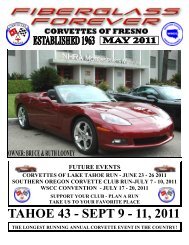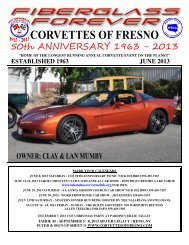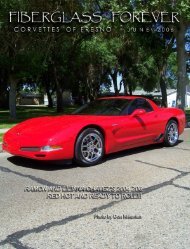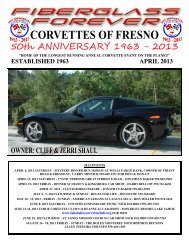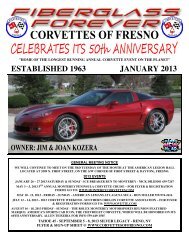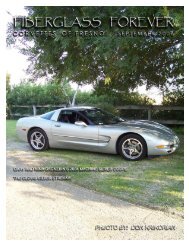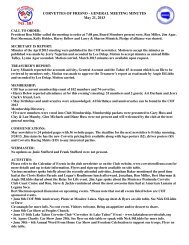Download
Download
Download
You also want an ePaper? Increase the reach of your titles
YUMPU automatically turns print PDFs into web optimized ePapers that Google loves.
olling resistance, steering effort and road noise, contributing to a more nimble feel, more<br />
immediate steering response and greater touring comfort and efficiency.<br />
Dimensionally, the new Corvette’s wheelbase is approximately an inch longer than the previous<br />
generation, with front and rear tracks that are almost an inch wider. Those changes provide a<br />
more stable feel, particularly at high speeds, while the turning radius is decreased by<br />
approximately two feet for greater maneuverability in tight turns.<br />
The Corvette Stingray features standard 35mm-piston Bilstein monotube shocks that connect to<br />
dual-path aluminum shock mounts that separate the shock rod and shock body load paths. The<br />
Z51 Performance Package comes with 45mm-piston Bilstein dampers for more aggressive body<br />
control and track capability. Z51 is available with the third-generation Magnetic Ride Control,<br />
which features a new twin-wire/dual-coil damper system that reacts 40 percent faster, enabling<br />
improved ride comfort and body control.<br />
The new electric power steering system offers variable ratios and variable effort to tailor<br />
responsiveness and feel for each driving situation. It also delivers more precise control and<br />
feedback to the driver, along with greater variability of effort for high-performance driving and<br />
greater on-center sensitivity and linearity. Steering feel was further improved by increasing<br />
steering column stiffness by 150 percent, increasing intermediate shaft torsional stiffness by 600<br />
percent, and mounting the steering gear to the front cradle structure. As a result the steering<br />
system is five times stiffer than the previous generation.<br />
A smart electronic limited-slip differential (eLSD) is included in the Z51 Performance Package<br />
and continuously makes the most of the torque split between the rear wheels. The system<br />
features a hydraulically actuated clutch that can infinitely vary clutch engagement and can<br />
respond from open to full engagement in tenths of a second. It shifts torque based on a unique<br />
algorithm which factors in vehicle speed, steering input and throttle position to improve steering<br />
feel, handling balance and traction.<br />
“The electronic limited-slip differential transforms the Stingray by optimizing handling for the<br />
driving situation,” said Mike Bailey, vehicle systems engineer, chassis. “By continuously<br />
modulating the torque split between the rear wheels, the eLSD can improve traction<br />
accelerating out of corner, improve stability on the highway and enhance steering turn-in and<br />
responsiveness.”<br />
The eLSD is fully integrated with StabiliTrak and Performance Traction Management systems.<br />
Its calibrations vary among three modes, based on the Drive Mode Selector setting:<br />
Mode 1 is the default setting for normal driving and emphasizes vehicle stability<br />
Mode 2 is engaged when electronic stability control is turned off in the Sport or Track<br />
Driver Modes. This calibration enables more nimble turn-in and traction while<br />
accelerating out of a corner<br />
Mode 3 is automatically selected when Performance Traction Management is engaged.<br />
This calibration has the same function as Mode 2, but is fine-tuned to work with<br />
Performance Traction Management.<br />
Standard Brembo brakes, with four-piston fixed calipers derived from racing, deliver exceptional<br />
stopping power on the street or track. System highlights include:



